
On a fine evening when combining was in the forefront of people’s minds, and for our last walk of the Soil Farmer series this year a group of farmers met in Oxfordshire to find out more about why Julian Gold had been awarded the top prize in this year’s Soil Farmer of the Year competition.
Julian farms in Oxfordshire running a predominantly arable farm, with a flock of sheep that graze cover crops and areas of permanent pasture. The fundamental management principle on this farm is managing carbon; by growing high yielding crops there is a lot of carbon pumped back into the soil and by reducing tillage, once that carbon is in the soil it doesn’t escape. Julian explained his key philosophy on the farm
“I am not a farmer, I am a facilitator of photosynthesis and everything flows from that.”
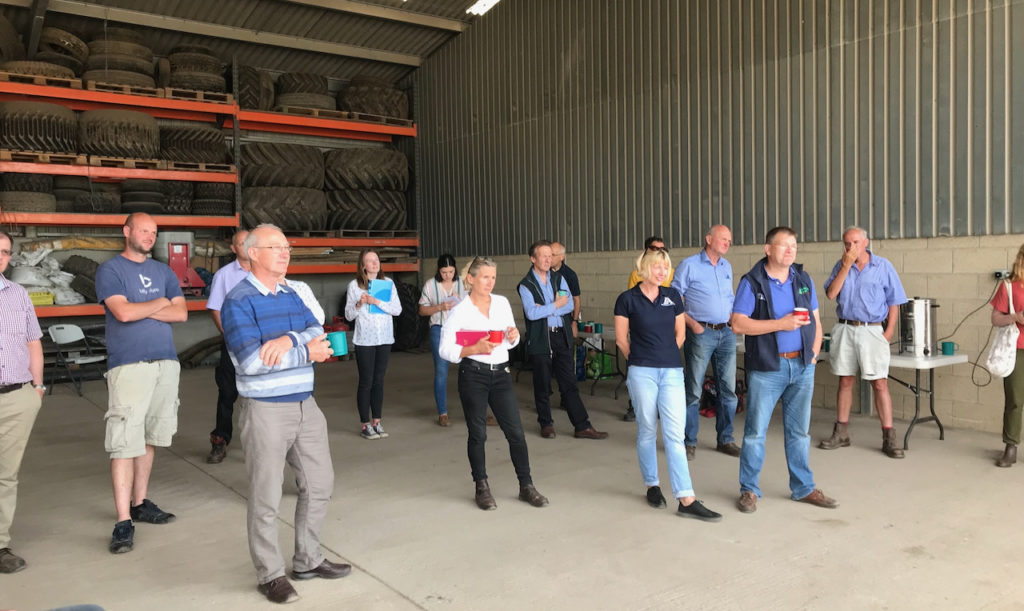
The key theme of the walk was focussed on the practicalities of residue management, specifically the management of barley straw and whether all of the issues that Julian has experienced was worth it. He is managing his system by returning all crop residues to the soil which is following his carbon principles, however practically it is causing some issues with crop establishment. By growing big photosynthetic crops, they are pumping carbon through the plant roots and into the soil which is great, and then by leaving the straw on the surface, it is acting as a soil biology primer. However dealing with the straw can present a challenge. The high carbon to nitrogen ratio of the straw will ensure that the biology have to work to breakdown the material, and Julian is convinced that the biology in his soil is now used to assimilating the straw. The nitrogen strategy on the farm currently is to apply it little and often however over the next few years, cutting back on nitrogen is a key management aim.
The farm occupies 800 ha and is mostly owner occupied. Julian runs a 6 year rotation, which is rape, wheat, spring barley, spring or winter beans, wheat and winter barley. There is flexibility between whether he grows winter or spring beans, and there is a guaranteed cover crop before spring barley after winter wheat, and if spring beans are grown after the spring barley. The farm runs a controlled traffic system which Julian started in 2012 which is based on 10m, which means that 20% of the field is ever driven on and 80% is not touched. No deep tillage is done and the carbon and root systems are protected. Julian was keen to recommend that everyone could try using a controlled traffic system at harvest, to minimise the potential damage by grain trailers and the combine. The soil is a silty clay loam over chalk which is a kind soil to run this type of system on.
Crops and residue management
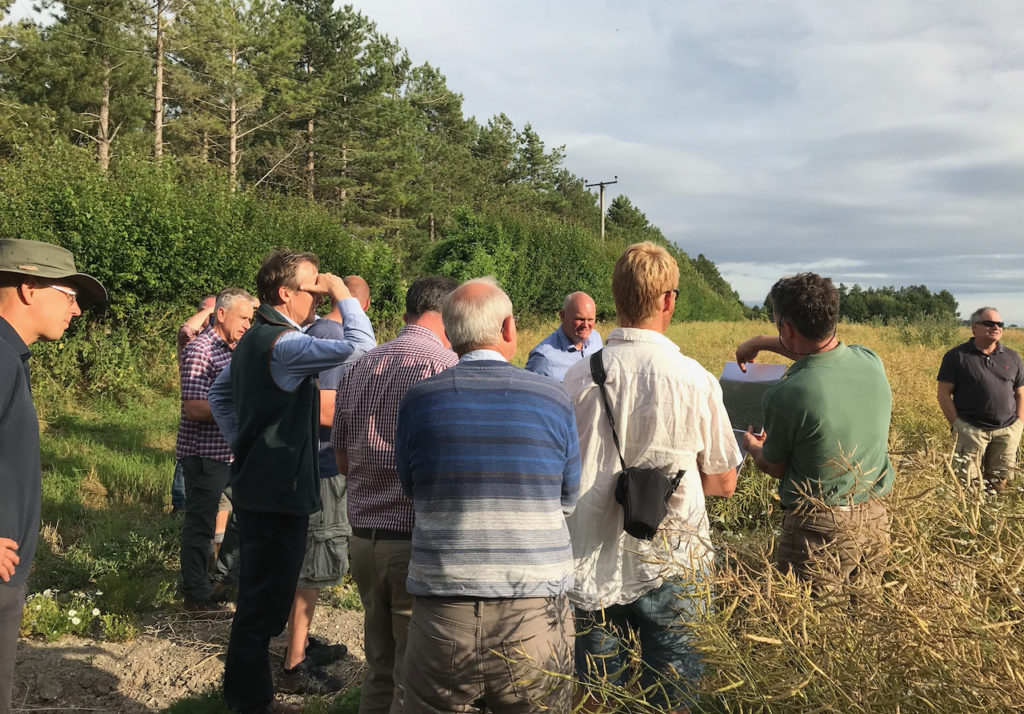
The first field that we visited was a field of oil seed rape. This field had previously grown winter barley, and had a lot of chopped straw on the surface.
The crop had established fine apart from an area where combining had carried on too long into the evening and straw chop quality was bad. A big issue with high volumes of straw residues is maintaining soil to seed contact as the soil surface layer is very fluffy and hard to consolidate. Another issue the farm struggles with is the battlement effect left behind when direct drilling with the tine drill. The undisturbed areas of soil support the rolls and make it difficult to consolidate the seed trench.
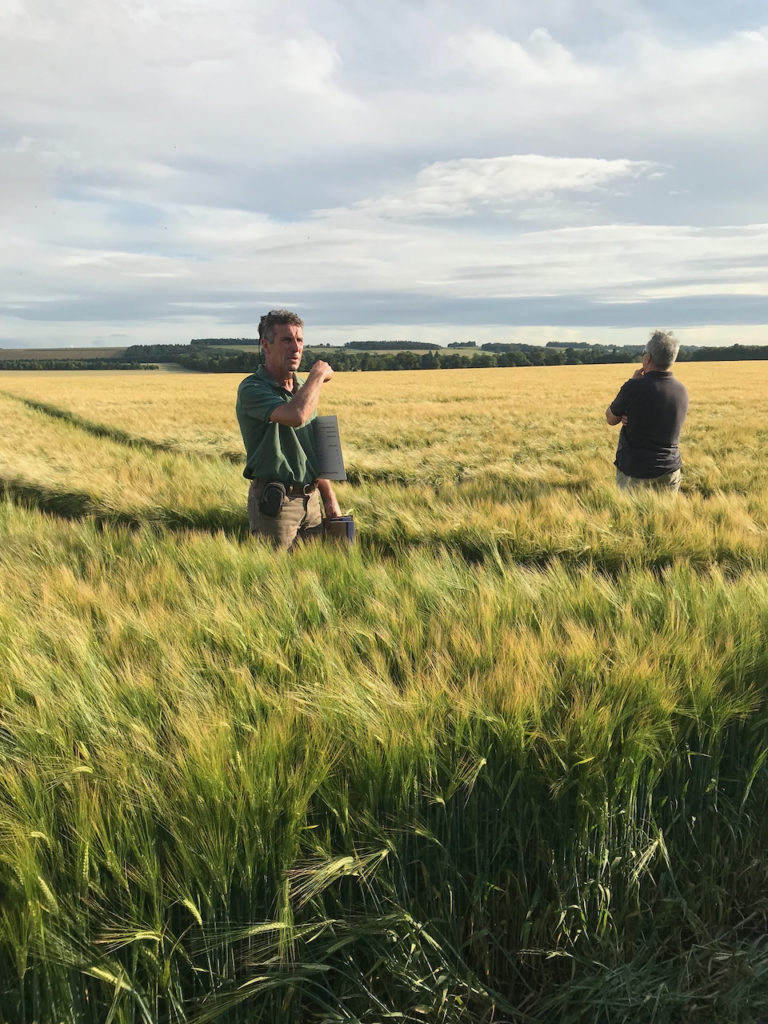
After the rape we went to look at a field of barley, which had had a cover crop before which had been grazed by sheep. The cover crop had a high biomass, as (similar to the cereals) Julian is keen to maximise photosynthesis even in the cover crop and provide a variety of rooting depths and species.
Julian also explained how he creates the right mindset for soil friendly farming by imagining a fictional scenario “that way back in time as life was evolving on the planet, an intelligent soil ecosystem evolved first and needed a food source so created plants to grow and harvest sunshine and carbon dioxide to feed the soil community. The farmers function is to tend the food producing slaves and in return is allowed to take the seeds as payment!”, Julian explained that
“when you have this focus on farming for the soil it is a win win scenario because the grain yields become better and more robust over time.”
Julian has been growing cover crops since 2014, starting off with vetches and black oats, and now including high biomass mixes. They are mob stocked with 50% of the cover trampled and the field is never turned brown with bare soil. The field is then sprayed off and drilled. Until the point that it is sprayed off, something is growing, providing soil cover. This year, on this field, however grazing with the sheep was challenging, as they couldn’t take advantage of the good weather early in the season to drill as the sheep were still grazing it, but Julian is still keen on the value of the sheep in the rotation, explaining:
“Everything is an integrated holistic system, and you have to take some things on the chin to achieve the end goal.”
There were a few discussions about soil assessment, and Julian explained how he had done a range of soil tests, including biological health, and an inter – lab comparison – which showed the importance of using a consistent lab for testing! However there is no substitute for looking at crops and digging holes, and knowing your soils. Julian explained:
“If you know your soil and are on the right trajectory, you don’t need to test. I can see the straw disappearing and see worm middens, I know it’s healthy and doing what it should be, but it can take time.”
Next, we had a quick stop at a different rape field which had been drilled with the Moore disc drill. The group had seen pictures of this field back at the grain store. It had been drilled into chopped winter Barley straw into the same conditions as the first field but hairpinning of straw in the seed slot had led to very poor establishment. Looking at the crop you wouldn’t have guessed it had been challenged. “I never underestimate the restorative power of oilseed rape,” Julian explained, “which is all back to soil, if you have healthy soils, the crops want to grow, but it’s still difficult to believe that this crop has come from that start!”
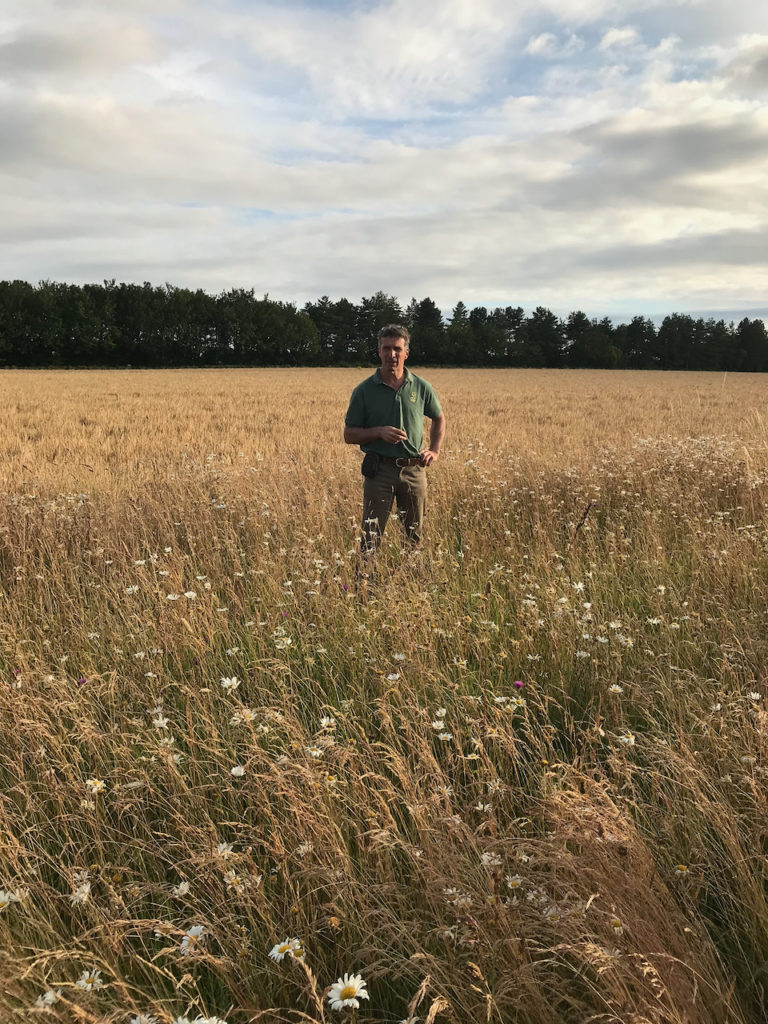
We then went to look at some pollinator strips that have been planted through a field of barley. These strips are part of the ASSIST project which is run by the Centre for Ecology and Hydrology which is looking to assess the effectiveness of management systems that advance sustainable intensification. Traditionally flower margins would be planted round the edge of the field, however the project is trialling putting these strips in the middle of the field 90m apart. The seed mix was broadcast onto the surface and the researchers are monitoring whether the beneficial insects are managing to cover the field from the strips. While the main benefits from these strips are crop protection and improvement of biodiversity, it will also be interesting to see whether there is a soil health benefit from these being present. The strips are topped once a year and have no fertilisers or pesticides applied.
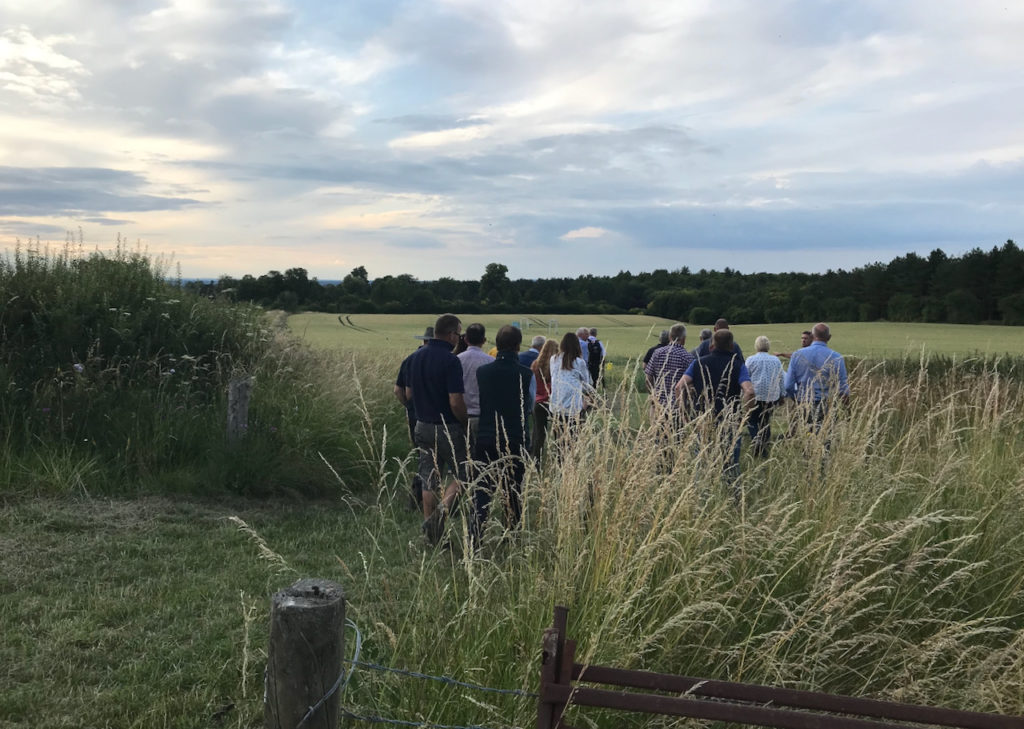
The last stop of the tour was to look at a different research project looking at greenhouse gas emissions from a range of different fertilisers and composts, both in and out of the soil. The research is measuring a whole range of parameters and doing it throughout the season so should be able to understand what happens as the crop grows. There were wider discussions here about the use of crop protection products and particularly about the use of insecticides. Julian is a bee keeper with 2 hives and as such, doesn’t use summer insecticides routinely. He advocates that all farmers should become bee keepers. He explains, “as with all things its about a change of mindset. This is true of fertiliser use, crop protection and carbon farming.”
Future plans
Julian is keen to look at the possibilities of undersowing, and is trialling a few acres where he is undersowing clover and medic as an experiment. Now that the soil organic matter levels have built up, the next plan is to start to reduce Nitrogen levels and improve nitrogen use efficiency which will reduce nitrous oxide emissions, with the ultimate aim of running a farming system which has lower inputs and positive economic and environmental benefits.
A thought provoking evening was had by all, and Julian’s enthusiasm for trying new things as well as his knowledge of the system was inspiring. A big thank you to Julian and his team for a fantastic evening.

